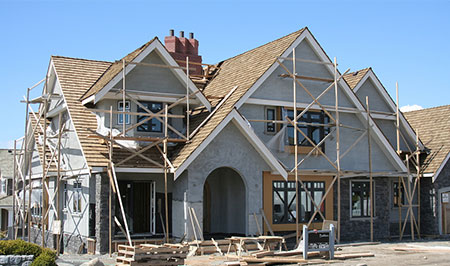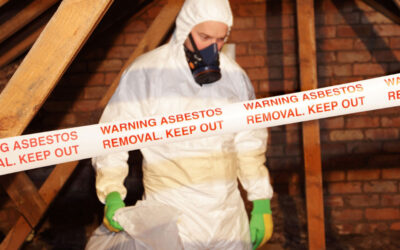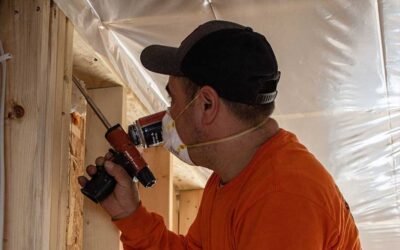In our beautiful state with its chilly winters and wet seasons, keeping your home cozy and energy efficient can be a challenge. A blower door test is a highly effective way to help homeowners identify air leaks and improve home energy efficiency. Whether you’re building a new home or trying to solve comfort issues in an older one, take a deeper look at this valuable diagnostic tool.
What is a Blower Door Test?
A blower door test (often called an air leakage test) is a great way to measure the level of air leakage in your home. It determines how airtight (or leaky) your home is. A technician places a large fan into a frame that fits inside your front door. When the fan runs, it creates air pressure by pulling outdoor air in through penetrations and gaps in the building envelope.
The test will provide an “air leakage score” based on air changes per hour (ACH) at 50 pascals (ACH50). The fewer air changes per hour (and lower the score) means the tighter and more efficient home you have. This test is great at leak detection. It makes drafts obvious and reveals hidden leaks around your exterior windows and doors, outlets, and lights.
How Does Blower Door Testing Work?
Let’s break down exactly how the test works.
Setup
Close all exterior windows and doors, open inside doors, and mount the temporary door panel with its built-in fan system.
Depressurization
The fan removes air from your house, lowering indoor pressure and forcing outdoor air in through the leaks.
Leak Detection
The person performing the door test may utilize tools like smoke pencils and infrared cameras to find specific leak locations.
Results
Your technician will measure the air leakage rate and provide the results showing the air changes per hour in Pascals. An ACH50 score of 10+ means you have a very leaky home. A good number, showing your home is energy efficient, is between 3 and 5. Newly built homes in Washington state are required to undergo a blower door test and achieve an ACH50 score of 5 or less to meet Washington State Energy Code requirements.
The process only takes about an hour and doesn’t damage your home. You will get a clear understanding of your home’s air tightness and the best strategies for an improvement plan.
Why Blower Door Testing Matters
Lower energy bills
Did you know that air leaks in your home can account for 25–40% of your heating and cooling energy use? Sealing them means reducing air waste and cutting your utility bills.
Improved Comfort
Sealing air leaks makes your home more comfortable and helps eliminate drafts and inconsistent indoor temperatures. It also reduces unwanted air infiltration, noise, and moisture from entering your home.
Healthier Indoor Air Quality
Breathe easier in a more airtight home that helps keep out dust, pollen, mold spores, radon gas, and even pests.
Moisture and Mold Prevention
With our damp climate, sealing air leaks helps fight moisture challenges. Protecting your building envelope with air sealing helps prevent condensation issues and long-term structural damage. It also weatherproofs your home against unwanted moisture and varying temperatures.

When Should You Consider a Blower Door Test?
You should conduct a blower door test if:
- You’re building a new home (Washington requires ACH50 ≤5 for all new homes).
- You’re buying or selling your home.
- You notice drafts or high energy bills.
- You’ve recently added insulation or done weatherproofing and want to verify improvements.
- It’s been 10+ years since you last tested your home.
Remember, professional testing is the gold-standard for measuring air leaks and gives you the most accurate results.
What to Expect from the Process
The Three-Step Process
- Initial assessment: Receive an evaluation where you discuss comfort issues and conduct a walkthrough.
- Customized plan: Work together to create tailored recommendations based on your home’s needs and discuss test details.
- Test and results: The fan is set up and the test is given with real-time leak detection. You receive and discuss the results and your improvement plan.
It’s important to hire qualified, experienced professionals with calibrated equipment that use a collaborative approach. They’ll handle the technical work while you provide home access, and then together you’ll make the best energy improvement decisions for your home.
Create an Airtight Home Today
If you’re concerned about the efficiency and comfort of your home, a blower door test is one of the best ways to check your Washington home’s energy efficiency. It identifies air leaks in your home so you can make targeted improvements that keep warm air in and cold drafts out in the winter. At Specialty Group, our dedicated team is here to provide you with local expertise, quality blower door testing, and a customized improvement plan for your home. Homeowners know they can depend on us for a cozier, more energy-efficient Spokane area home year-round. Contact us today to schedule your free home assessment.
Works Cited
U.S. Department of Energy. (n.d.). Detecting Air Leaks. Energy Saver Guide. Retrieved from https://www.energy.gov/energysaver/detecting-air-leaks energy.gov
U.S. Department of Energy. (n.d.). Blower Door Tests. Energy Saver Guide. Retrieved from https://www.energy.gov/energysaver/blower-door-tests energy.gov
Washington State University Energy Program. (2018). Building Air Leakage Testing (2018 WSEC) [PDF]. Retrieved from https://www.energy.wsu.edu/Documents/Air%20Leakage%20Testing_2018%20WSEC.pdf energy.wsu.edu
ENERGY STAR. (2005). Air Sealing: Building Envelope Improvements [Fact sheet]. U.S. Environmental Protection Agency and U.S. Department of Energy. Retrieved from https://www.energystar.gov/ia/home_improvement/home_sealing/AirSealingFS_2005.pdf energystar.gov
U.S. Department of Energy. (n.d.). Home Energy Audits. Energy Saver Guide. (Referenced for general process guidance and context.)



